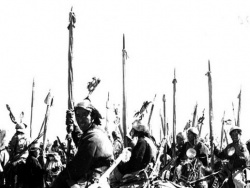The red-faced men II: China or Tibet?
In the illuminating discussion which followed my last post, it transpired that I was not quite correct in saying that Tibetans have always understood “the land of the red-faced men” to be Tibet (thank you, ‘Dab’). In fact no less an authority than the great historian Büton (1290-1364) suggested that in one particular source it referred China:
In the Accounts of Ba it is said that the land of the red-faced men is China.
Well, the Accounts of Ba is one of our oldest Tibetan histories, and we should pay attention to what it says. When we look into the Accounts of Ba we do indeed find a mention of a prophecy about Buddhism coming to the land of the red-faced men. A version of this story appears in both the Accounts of Ba as published by Gönpo Gyaltsen in 1980 (Sba bzhed) and the older version published by Pasang Wangdu and Hildegarde Diemberger in 2000 (Dba bzhed).
Let’s look at the oldest version of the story. While Trisong Detsen is still young and has yet to establish Buddhism in Tibet, two members of the Ba clan, Ba Selnang and Ba Sangshi, are sent to China to receive dharma texts from the Chinese emperor (this is before the invitation of Śāntarakṣita and Padmasambhava to Tibet). While they are travelling, an astrological expert in Bumsang predicts their arrival and identifies them as bodhisattvas. So by the time Ba Selnang and Ba Sangshi arrive at the Chinese court, the rumour that they are bodhisattvas has preceded them, and they get quite a reception. I quote from the Wangdu/Diemberger Accounts of Ba:
The Chinese emperor said [to Ba Selnang and Ba Sangshi]: “You are the two bodhisattvas who should have arrived at around this time according to the expert in astrological science in Bumsang. Even Kim Hashang prostrated to you. The Buddha prophesied that a spiritual master for the practice of the holy dharma would appear in a time close to the final 500 year [period of the dharma] in the land of the red-faced men. According to your behavior, you are certainly the prophesied ones.”
It is possible to see from this passage what made Butön think that the land of the red-faced men was supposed to be China. There is some ambiguity about whether the emperor is linking the prophecy to Ba Selnang and Ba Sangshi’s appearance in Tibet or to their arrival in China. I would certainly argue that the former was intended rather than the latter. Fortunately I can draw on the support of another great Tibetan historian here.
Pawo Tsuglag Trengwa (1504-1564/6) was the author of the most important Tibetan historical work yet to be translated into English: A Scholar’s Feast (Mkhas pa’i dga’ ston). As a historian, Pawo was notable for his critical approach to his sources and his use of neglected and early source material. Rather than just accept Butön’s statement, he went back to look at the Accounts of Ba, and this was his conclusion:
According to the all-knowing Butön, the Accounts of Ba state that the country of the red-faced men is China. But in the Accounts of Ba it is said that when Ba Selnang and Ba Sangshi were sent to China to receive the dharma, an expert in divination said: “Emanations of bodhisattvas looking like this will come as messengers,” and he drew a picture. So when [[[Ba Selnang]] and Ba Sangshi] arrived they were given a great reception by the [[[Wikipedia:Chinese|Chinese]]] emperor. [The emperor] said, “There is a prophecy that a bodhisattva will appear in the land of the red-faced men who will be a source of the dharma. I am certain that it is you,” and he gave them 1,000 volumes of dharma. So it is very clear that the land of the red-faced men is indeed Tibet.
- * *
References
1. Obermiller, E. 1931-2. The history of Buddhism (Chos ḥbyung) by Bu-ston. I The Jewellery of Scripture, II The history of Buddhism in India and Tibet. Heidelberg: O. Harrosovitz. Reprint 1986 New Delhi: Sri Satguru Publications. [p.108]
2. Wangdu, Pasang & Hildegarde Deimberger. Dba’ bzhed: The Royal Narrative concerning the bringing of Buddha’s Doctrine to Tibet. Vienna: Verlag der Österreichischen Akademie der Wissenschaften. [pp.48-50]
Tibetan sources
1. Bu ston rin chen grub. Chos ‘byung gsun rab rin po che mdzod [[[History of Buddhism]]]. Beijing: Khrung go bod kyi shes rig dpe skrun khang. 1988.
2. Dpa’ bo gtsug lag ‘phreng ba. Chos ‘byung mkhas pa’i dga’ ston [A Scholar's Feast]. Varanasi: Vajra Vidya Library. 2003. [pp.167-8]
3. Sba bzhed [The Accounts of Ba]. Mgon po rgyal mtshan (ed.). Mi rigs dpe skrun khang. 1980, 1982. [p.7]
